Analyzing the Price of Mobility: Desktops vs. Laptops
by Jarred Walton on September 7, 2013 5:55 PM ESTGPU/Graphics Performance Discussion
The other area of performance we want to look at is the GPU/graphics side of the equation. Where CPU performance has really started to level off – only overclocked CPUs or hex-core/octal-core options really hold serious performance advantages over the fastest mobile CPUs, and then only in heavily threaded workloads – the same can’t be said of graphics chips. Part of the problem is power requirements, as high-end desktop GPUs can draw up to 300W under load, which is three times what the most powerful mobile GPUs are rated to draw. The form factor also comes into play, but really I think power is the far more limiting factor.
Of course, there's a big difference in terms of what we do with CPUs vs. GPUs and how we do it. Most CPU-intensive tasks don't easily scale beyond a certain level of multi-threadedness, and some tasks really don't scale at all. The easiest example is anything that requires user input: no matter how fast your CPU gets, Word isn't going to type any faster than your fingers can go – or if you use speech recognition, any faster than you can dictate. Graphics on the other hand is practically infinitely parallel, where we can break things down into smaller and smaller pieces of a screen being rendered/computed by individual GPU cores. Many tasks on the CPU don't scale beyond four or maybe eight cores, but graphics is easy to scale to thousands of cores and beyond. So GPUs can get as large/fast as we can conceivably make them and there are still ways to tap into that performance potential; that's why modern systems typically have GPUs that consume two to ten times as much power as the CPU(s).
Let’s again put together some comparisons, only this time we’re a bit more limited in what we’ve tested with modern GPUs – on our desktop tests, we only have an overclocked GTX 680 and a GTX 780 with all of our gaming results, while on mobile we have a few additional reference points. I’ve also added Bioshock Infinite and Sleeping Dogs numbers for additional GPUs from our GPU 2013 test suite, but that’s only two of the seven titles we’re testing on laptops. We’re now looking at entire systems, but the GPUs are the primary factor in gaming performance. Also note that our reference point (1080p Max Detail, usually with anti-aliasing) is far more demanding than what most gamers actually require, but in terms of a performance discussion at least we can get an idea of where mobile GPUs stand.
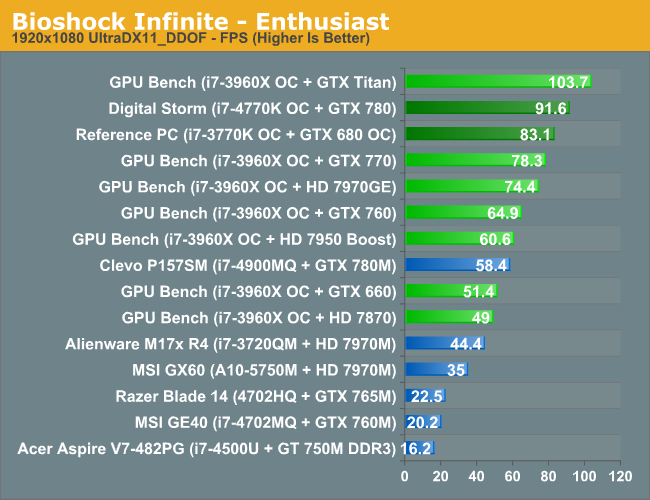
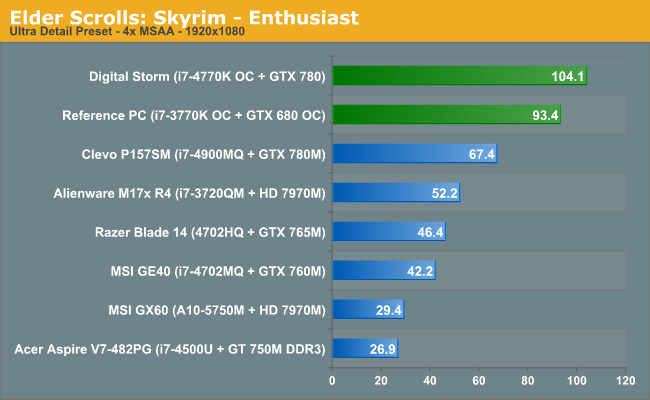
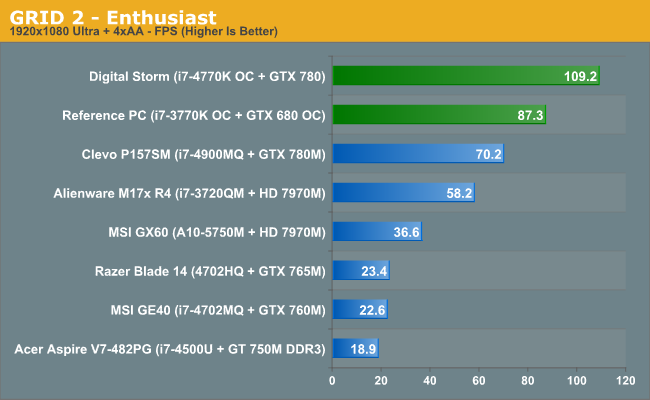
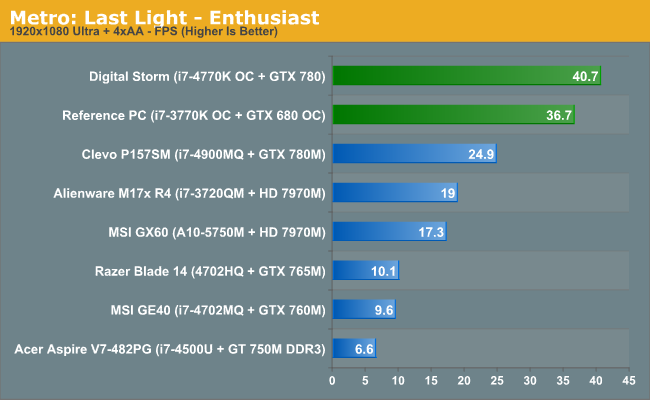
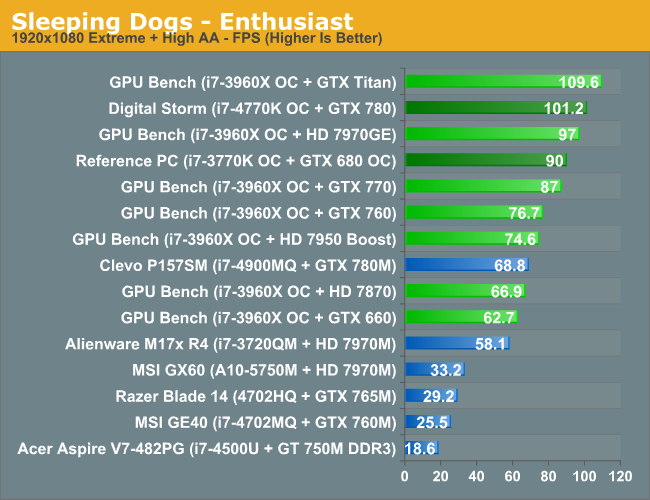

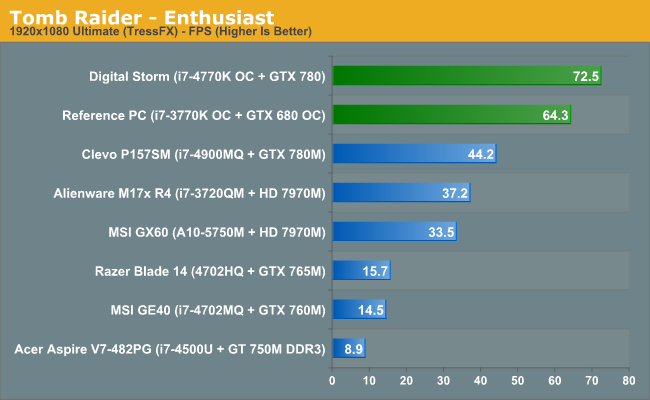
As far as replacing gaming desktop performance with a notebook is concerned, we’re nowhere near close to accomplishing this task. CPU requirements for the vast majority of users have reached a plateau during the past five or so years, but for graphics (games) we can still use pretty much all the horsepower available. The fastest mobile GPU we have right now, the GeForce GTX 780M, ends up delivering performance that falls roughly half way between the GTX 660 and GTX 760, or if we look at the Digital Storm system Dustin tested, it offers 60-70% of the performance of that desktop. Moving down to the lower performance mobile GTX parts like the GTX 765M, we haven’t tested any desktop GPUs in recent history that are anywhere near that slow – even the GTX 660 tends to be more than twice as fast as the GTX 765M and the GTX 560 Ti is still 50% faster. Drop one level further to the GT 750M (DDR3) and performance is about 60-80% of the GTX 765M! It’s not that you can’t game on a GT 750M or GTX 765M, but you’ll definitely need to drop the details down from max and turn off anti-aliasing. Finally, no matter what you do with a notebook, you’re not going to match the performance of the fastest desktop GPUs – the GTX Titan nearly doubles the performance of the GTX 780M, and even SLI GTX 780M isn’t likely to beat a Titan on a consistent basis.
Looking at pricing is also illuminating. Most notebook vendors charge around $650 (give or take) for a second GeForce 780M on the Clevo P370SM, compared to the desktop GTX 760 (which has slightly higher performance) that can be purchased for $250. Meanwhile, the desktop GTX 780M sells for the same $650 price as the GTX 780 while offering only 60-70% of the performance you get from the desktop GPU; the GTX 680 and GTX 770 have the same number of CUDA cores (1536) and go for $400, delivering superior performance at a substantially lower cost. The pattern continues as we move down the product stack; the slowest desktop Kepler, the GeForce GT 630, is a $65 card that has slightly higher clocks than the GT 750M, never mind the GT 730M and GT 740M, but the GT 730M is typically a $70 upgrade on a notebook. The GTX 765M has the same number of cores as the $130 GTX 650 Ti but with lower clocks; it reputedly sells for close to the same price to laptop OEMs as the desktop GTX 760 we mentioned as a performance equivalent of the GTX 780M.
Of course, where you can easily add a GPU to most desktops, with laptops you’re basically stuck with whatever you initially purchase. I noted in the Gaming Laptop Guide last month that the lowest price I could find for a notebook with a GTX 780M ends up around $1750 (including the OS with a 1TB HDD). For equivalent performance (more or less), we can take the desktop we listed above and add a GTX 760 GPU, with a slight PSU upgrade as well just to be safe. Here’s what we end up with:
| Mainstream Gaming Desktop PC | ||
| Component | Description | Price |
| CPU | Intel Core i5-4670 (Quad-core, 3.4-3.8GHz, 6MB L3, 22nm, 84W) | $200 |
| Motherboard | ASRock Z87 Pro3 LGA-1150 | $115 |
| GPU | GeForce GTX 760 | $250 |
| Memory | 2x4GB DDR3-1600 CL9 1.5V RAM | $65 |
| Storage | Seagate 1TB 7200RPM HDD | $70 |
| Optical Drive | SATA DVDRW (Lite-On) | $18 |
| Case | Antec Three Hundred | $60 |
| Power Supply | Rosewill Green RG530-S12 530W 80 Plus Bronze | $55 |
| Operating System | Windows 8 64-bit (OEM) | $100 |
| Total | $933 | |
Opting for a gaming notebook thus carries a hefty price premium, nearly doubling the price of a similar performance desktop. Yes, the notebook still gives you a battery, display, keyboard, touchpad, and speakers as part of the package, but if you already have those for an existing desktop they’re not really necessary. The price premium for high-end gaming notebooks has certainly come down from the 2x-3x we used to see (though you can still get to that range with SLI notebooks), but we’re nowhere near parity like we are on the CPU side of things. As an alternative, desktop GPUs are also able to hit much higher performance levels at a similar cost to a high-end gaming notebook.
Given the various options, many people have concluded that it’s far better to have a decent gaming desktop like the one above and then to spend another $500-$1000 on a good laptop for when you need to go mobile. That’s generally my recommendation as well – for all the gaming notebooks I’ve reviewed over the years, I still turn to my desktop system 95% of the time when I’m looking to play a game. On the other hand, not everyone wants to worry about having two computers and syncing data between them, and there are also space limitations to consider. Finding a spot for a 10 pound gaming notebook in a college dorm is easy enough; finding space for a gaming desktop with display, speakers, keyboard, and mouse can be a bit more difficult. And if you’re regularly on the road and want to take your games with you, you’ll need the laptop regardless.
There’s no right answer for how to do things, of course. Some people love gaming notebooks and others don’t see the point. But while you can certainly make a case for typical notebooks/laptops now being close to price parity with similar performance desktops, once you add gaming into the mix you’ll need to pay the mobility piper his due.










110 Comments
View All Comments
puppies - Saturday, September 7, 2013 - link
Second sentence should be used not uses.brucek2 - Saturday, September 7, 2013 - link
AnandTech, where user comments go much, much further. What a treat to get such a thorough reply to a few readers questions, and barely 24 hours later.My only quibble might be that I believe all these performance numbers are at stock speeds? A high end desktop could probably get another 10-30% from OC'ing, while a high end laptop would probably get either no or significantly less boost due to less cooling capacity (and less support from the BIOS, mobo, etc.)
Even so I don't think that really changes the overall picture. I was surprised to see the single threaded performance range being so narrow (only ~2x), and agree that for most use cases, most of the time, even the bottom end is going to be fine. The much greater 6x+ range on the multi-threaded / gaming side is of course the big factor for those that need it. And its great to see a trusted source call out (even if gingerly) the practice of using the same price and same name for a mobile GTX 780 that is barely in the same league as the desktop counterpart, even at stock speeds.
I also couldn't agree more on the SSD comments. Especially on budget laptops where the target audience is not likely to ask any questions about the storage subsystem, there is a real likelihood of getting the slowest possible hard drive, which can end up making bottlenecks even out of situations where SSD users long ago forgot that storage was even a factor. A situation usually made worse by the likely ton of bloatware that will consume the limited hdd bandwidth by loading and updating itself, downloading ads, etc. I remember my first high end gaming laptop, I thought the cpu was defective or being improperly throttled until I finally realized that yes the 2.5" 5400 rpm hd was really that bad and causing that much trouble.
Anyway thanks for a great article, I know I'll be directing some shoppers to it over the coming months and I hope its helpful for other folks as well.
nerd1 - Saturday, September 7, 2013 - link
Most high performance gaming laptops allow OC'ing for both CPU and GPU, and some are even factory overclocked. Also now pretty much ALL laptops (except for some fruit-labeled ones) has one or two empty mSATA slots for easy SSD upgrade.JarredWalton - Saturday, September 7, 2013 - link
My experience with overclocking notebooks is that, at best, you might get an extra 2 bins of CPU performance on the high-end CPUs before you run into thermal limits and the CPU starts to throttle. I saw this with the Mythlogic (Clevo P157SM), where the 4700MQ was able to run at max OC (2 bins) without any issues, but the 6 bin overclocking headroom of the 4900MQ basically didn't do much for performance. Desktops can definitely overclock more, and that's another factor for some, but on mobile systems I think the benefits of overclocking are usually outweighed by the increased heat/noise.JarredWalton - Saturday, September 7, 2013 - link
As for Bruce2K, I read your comment and thought, "Yeah, I could probably do that for the readers and it should prove interesting." Thanks for the idea!nerd1 - Saturday, September 7, 2013 - link
I heard haswell and new 780M is worse than previous-gen ones in terms OC'ing. Some people claim they OC'ed their 680M to the same performance as 780M. So OC is definitely possible and can be effective on some laptops. That said, personally I never do OC'ing myself.WarrenSmith - Saturday, September 14, 2013 - link
Love my job, since I've been bringing in $5600… I sit at home, music playing while I work in front of my new iMac that I got now that I'm making it online( Click on menu Home)http://goo.gl/OHUOdW
brucek2 - Saturday, September 7, 2013 - link
I know the basic controls are often there, but can you really get the same results out of them at acceptable stability, noise, and chassis heat (ie where you place your hands) and without triggering throttling? That's great news if you can.Watwatwat - Thursday, October 10, 2013 - link
Yep but the thermal issues in a laptop just can't be avoided, theres no getting around having a tiny heatsink and basically almost no fan. Also overclocking on a gaming laptop is a great way to turn 2 hours of battery life into 1;) Last I checked overlocking doesn't result in linear increase in power consumption.WinterCharm - Thursday, September 12, 2013 - link
I did manage a 19% GPU overclock on my laptop... and while performance improved, it'll never be anywhere near what it is on a desktop.